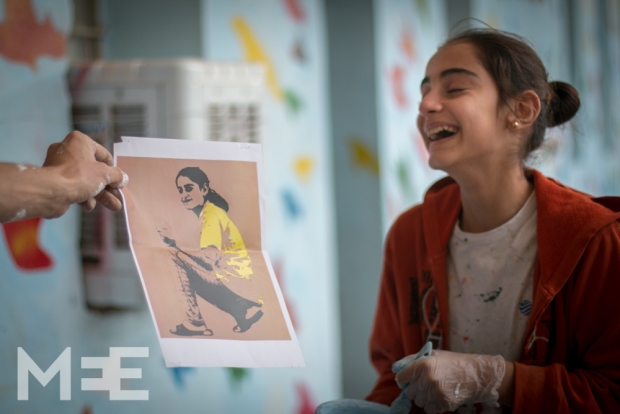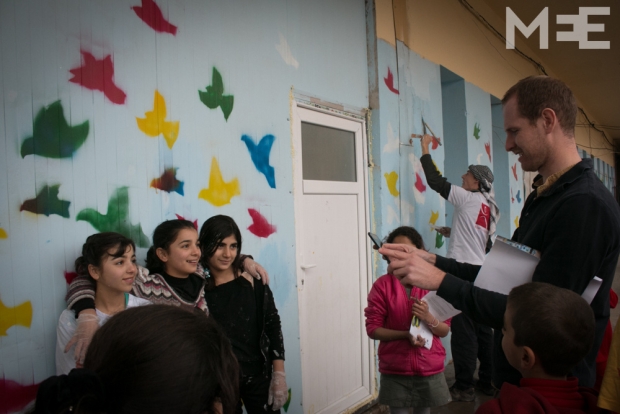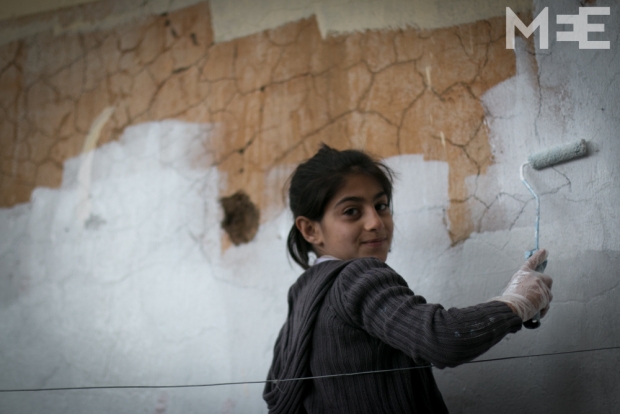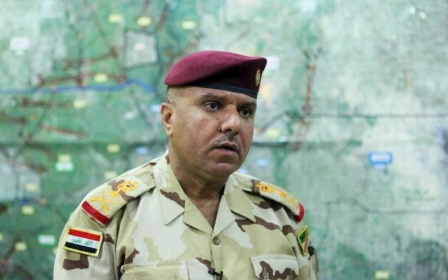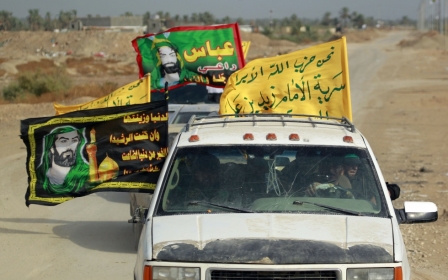Iraq’s painted castle of dreams
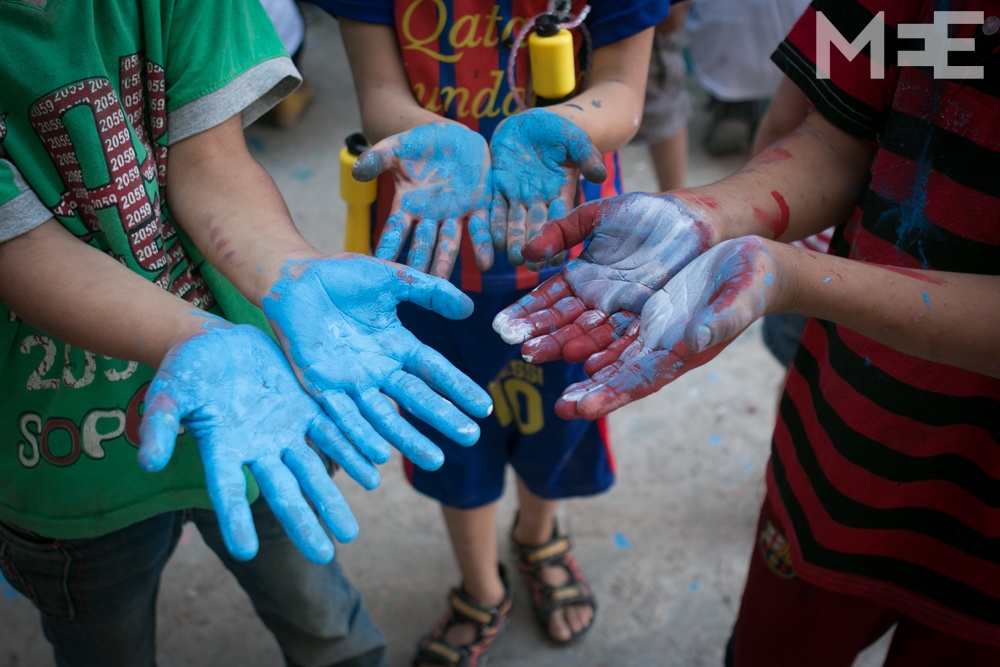
AKRE - Children’s laughter rises from behind the ominous walls of what was once a military fort used by Saddam Hussein in his battle against the Kurds of Iraq. Inside, gaggles of animated children march determinedly through the courtyard with buckets of paint, spray cans and brushes - they are preparing to continue painting the bleak walls of the building they have come to call home.
The Saddam-era fort, believed by some to have been used as a prison by the ruthless dictator and referred to as a “castle” by the locals, sits at the feet of the historically Assyrian town of Akre in Iraq’s Kurdistan Region and is home to approximately 1,400 Kurdish refugees from Syria who were forced to flee their hometowns in August 2013 as a result of the civil war.
More than a year after the mass exodus of hundreds of thousands of Syrian Kurds, approximately 225,000 registered refugees are still living in the Kurdish enclave, their plight largely overshadowed by the more recent mass internal displacement of Iraqis as a result of Islamic State advancements in north Iraq.
Art therapy
The transformation of the unlikely refugee camp from derelict building to an open-air art exhibition began in April when local NGO Rise Foundation introduced the Castle Art project.
The project came to life when photographer and former Rise member, Nils Henrik Johansson saw potential in a building that had been left untouched for decades. “I was thinking of ways in which I could improve their quality of life and thought about getting the children involved in painting the walls. Castle Art is a way to give the children of Akre camp responsibilities as well as a creative activity,” explained Johansson.
“As the project went on, the benefits became increasingly clear - it was a therapeutic project for everyone. For those who took an active role as well as for those who passively admired the art,” he added.
Every Friday the young members of Rise journey north from Erbil to Akre to spend the afternoon painting with the children. Since April approximately half of the courtyard wall has been covered in paintings of colourful landscapes, natural sceneries and people.
Upon entering the camp, the image drawn by a child of a pair of hands forcefully emerging from a dark crack in the wall underline the collective resilience of the refugees and their struggle to rise from a dire situation. On the left the image of Damascus reminds visitors of the lives that the men, women and children in this camp have been forced to leave behind.
Onsite coordinator Kawther Ahamed is in charge of making sure that everything runs smoothly, keeping the children in check and acting as a translator between the refugees and the aid workers. “When we crossed the border the government brought us directly to Akre, the building was very old and horrible when we arrived - now it’s becoming nicer,” said the 24-year-old refugee, pointing at the mural behind her where dozens of colourful birds flew against the backdrop of a light-blue sky.
Kawther fled Damascus with her husband and two children. “Everything was becoming really expensive, there was no work, no water, no electricity, everything became so hard - but we stayed until the bombings began,” she explained, as her youngest child locked his arms around her legs.
“When Rise introduced the project I was very excited because all the children in the camp were becoming very bored, they needed something to express themselves,” said the young mother-of-two.
In April the children were asked to sketch on paper what they hoped to see on the walls - this unleashed a barrage of emotions related to the war. A young girl drew a member of the Islamic State being squeezed to death while another sketch saw Kurdish forces protecting a group of children from being killed by the Islamic State.
“Every picture talked about the war, the killings, the blood. But we are trying to make them do something else - flowers, nature, hope. To take them away from the war, because most of them saw the war, saw the blood,” said Kawther.
“The darkness is still there, it’s positive that they are distracted from that and have fun through art,” explained Project Manager Lucy Tyndall. “It’s good for them to work through it in their own time, eventually I would like to channel it a little bit more in a mural,” she added.
Fourteen-year-old Cheamn recalls sketching a playground being bombed by warplanes and while the traumas of war remain, she finds solace in painting more positive pictures, like natural landscapes. Inside the makeshift home she shares with her parents and three siblings the teenage girl and her father have painted a small mural of their own with colourful letters spelling out the name of their hometown: Qamishli.
“I left everything behind when I came here. Sometimes I used to paint back home, I’d like to see paintings of home here. I encourage my daughter to paint, to learn from other people and share the experience with her friends,” said Cheamn’s father, Kasan, who has struggled to find work since the family relocated to Akre.
Tyndall says the project aims to include as many representations of natural Syrian sceneries: “we want to bring a bit of home back to the camp,” she said.
Painting together has also worked as an incentive for children to interact amongst each other, forging much-needed friendships. “It helps them, I’m very happy when I see my children connect with other children,” said 36-year-old Hayatd Mohammad, mirroring the opinion of many parents in the camp.
For Hayatd, whose two daughters are actively involved in Castle Art, what used to be a bleak building haunted by the ghost of Saddam Hussein’s crimes is now a better place: “the old walls are gone, the new ones are beautiful - it’s a happier place,” she said.
Basic aid
But despite the children’s laughter and the brightly coloured walls, the adults have expressed concern at the dwindling supplies of food and basic aid that is being redirected towards internally displaced Iraqis and other international crises, including Ebola.
On 1 December the UN World Food Programme announced that it would be forced to suspend aid to more than 1.7 million Syrian refugees for lack of funding. “A suspension of WFP food assistance will endanger the health and safety of these refugees and will potentially cause further tensions, instability and insecurity in the neighbouring host countries,” WFP Executive Director Ertharin Cousin said in a statement.
“It’s becoming very difficult because nothing gets here, especially food. The monthly boxes always have the same food and the children sometimes need fruit and meat. I don’t have the money to buy this,” said Nahsa Abdullah, a refugee who found her way to Akre from Damascus.
Director of Rise Foundation Tom Robinson explained that the redirecting of basic aid comes as a result of the critical conditions being faced by the internally displaced persons (IDPs) versus the more established Syrian refugees: “many required immediate emergency relief having arrived with little more than the clothes on their backs,” said Robinson about the IDPs.
Below the colonnade Kawther balanced her eldest son in one arm while giving directions to the children who enthusiastically painted a dirty wall white to create a canvas they could later draw on. “During the week most come to me and ask when Rise will come here,” she said.
Twelve-year-old Sulaf Rasul agreed, she explained that painting had allowed her to interact with other children and make friends. “I’ve been learning a lot, I love drawing,” she said.
The next step, said Tyndall, is to introduce the children of the camp to the art of graffiti. “Given the environment, street art makes sense,” she said in reference to the urban-like setting the children find themselves in. “I want to get them thinking on two scales, pushing perspectives. We will keep going and teaching with the aim that they can look at the wall and drive the design process themselves,” added Tyndall.
Despite the difficult circumstances and the tangible sense of loss amongst the displaced families, a few hours of solace through painting became a clear reminder of the therapeutic power of art. As the afternoon came to an end and the men returned from the mosque, the courtyard filled with more people, many of whom curiously inspected the new graffiti of birds perched on columns and trees growing out of the sidewalks as the children stood proudly by.
New MEE newsletter: Jerusalem Dispatch
Sign up to get the latest insights and analysis on Israel-Palestine, alongside Turkey Unpacked and other MEE newsletters
Middle East Eye delivers independent and unrivalled coverage and analysis of the Middle East, North Africa and beyond. To learn more about republishing this content and the associated fees, please fill out this form. More about MEE can be found here.


